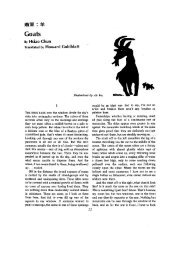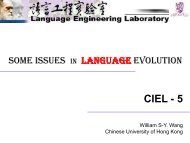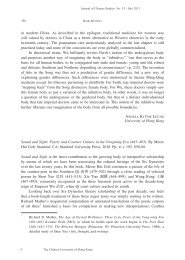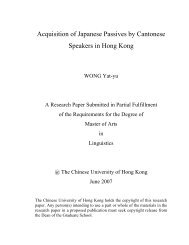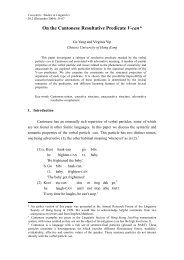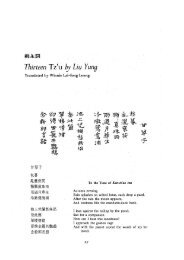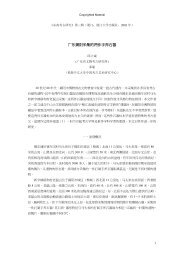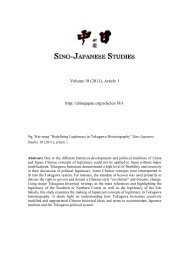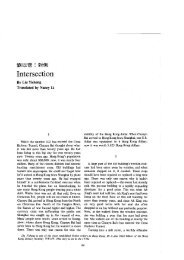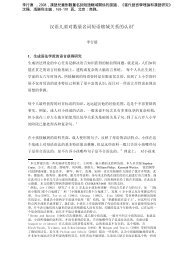Grammatical Performance in Simultaneous Interpretation: An Error ...
Grammatical Performance in Simultaneous Interpretation: An Error ...
Grammatical Performance in Simultaneous Interpretation: An Error ...
Create successful ePaper yourself
Turn your PDF publications into a flip-book with our unique Google optimized e-Paper software.
<strong>Grammatical</strong> <strong>Performance</strong> <strong>in</strong> <strong>Simultaneous</strong> <strong>Interpretation</strong>:<br />
<strong>An</strong> <strong>Error</strong> <strong>An</strong>alysis<br />
HUO Siliang<br />
A Research Paper Submitted <strong>in</strong> Partial Fulfillment<br />
of the Requirements for the Degree of<br />
Master of Arts<br />
<strong>in</strong><br />
L<strong>in</strong>guistics<br />
©The Ch<strong>in</strong>ese University of Hong Kong<br />
June, 2005<br />
The Ch<strong>in</strong>ese University of Hong Kong holds the copyright of this research paper. <strong>An</strong>y<br />
person(s) <strong>in</strong>tend<strong>in</strong>g to use a part or whole of the materials <strong>in</strong> the research paper <strong>in</strong> a<br />
proposed publication must seek copyright release from the Dean of the Graduate<br />
School.
Table of Contents<br />
Abstract 1<br />
1. Introduction 2<br />
2. Literature Review 4<br />
2.1. Simultaneity 4<br />
2.2. Model<strong>in</strong>g SI 5<br />
2.2.1. Effort Model 5<br />
2.2.2. Language Process<strong>in</strong>g Model 7<br />
2.3. SI Output 11<br />
3. Purpose of the Present Research 12<br />
3.1. Research Question 12<br />
3.2. Choice of Parameter 13<br />
3.2.1. Topic Cha<strong>in</strong> 14<br />
3.2.2. Coord<strong>in</strong>ation 16<br />
4. Methodology 20<br />
4.1. Subjects 20<br />
4.2. Experiment Procedure 21<br />
4.3. Materials 21<br />
5. Results 23<br />
5.1. Part One: Topic Cha<strong>in</strong> 22<br />
5.2. Part Two: Coord<strong>in</strong>ation 25<br />
5.2.1. Some Clarifications 26<br />
5.2.2. F<strong>in</strong>d<strong>in</strong>gs from the Experiment 29<br />
5.3. <strong>An</strong>alysis 30<br />
6. Conclusion 35
7. Discussion 37<br />
7.1. Attentional Resources 37<br />
7.2. Studies of Different Language Background 37<br />
7.3. SI Studies and L<strong>in</strong>guistic Research 38<br />
References 39<br />
Appendixes 44<br />
Appendix A: Sample Transcript of Subject A (Consecutive <strong>Interpretation</strong>) 44<br />
Appendix B: Sample Transcript of Subject A (<strong>Simultaneous</strong> <strong>Interpretation</strong>) 45<br />
Appendix C: Sample Transcript of Subject A (Free Narrative) 48
Helen Huo Siliang 04288470<br />
Abstract<br />
In simultaneous <strong>in</strong>terpretation (SI), over 85% percent of the time <strong>in</strong>terpreters are<br />
speak<strong>in</strong>g and listen<strong>in</strong>g at the same time; <strong>in</strong>terpreters need to split attention and the<br />
available mental capacity is limited (Gerver 1971). SI <strong>in</strong>volves cont<strong>in</strong>uous listen<strong>in</strong>g<br />
and analyz<strong>in</strong>g (L), memory (M), production (P) and the coord<strong>in</strong>ation (C) of these<br />
three tasks. Therefore, Total Mental Capacity equals Listen<strong>in</strong>g plus Memorization<br />
plus Production plus Coord<strong>in</strong>ation (T=L+M+P+C) (Gile 1985). When any of L, M or<br />
P runs out of mental resource, problems occur <strong>in</strong> the <strong>in</strong>terpretation. For example,<br />
<strong>in</strong>terpreters pause when there is no mental resource for P. This helps to expla<strong>in</strong> the<br />
frequent addition, omission and translation mistakes <strong>in</strong> SI (Gile 1995). However,<br />
previous researches have not addressed the question whether grammatical<br />
performance deteriorates <strong>in</strong> SI when mental capacity has to be shared by multiple<br />
tasks.<br />
This study uses an experiment to compare grammatical performance <strong>in</strong> SI,<br />
consecutive <strong>in</strong>terpretation (CI) and free narrative. Three <strong>in</strong>terpreters (N=4) are given<br />
three tasks: 1) five-m<strong>in</strong>ute Ch<strong>in</strong>ese to English CI; 2) five-m<strong>in</strong>ute Ch<strong>in</strong>ese to English<br />
SI and 3) five-m<strong>in</strong>ute free narrative <strong>in</strong> English. The English coord<strong>in</strong>ator and is used to<br />
measure grammatical performance. The percentages of correct use of this coord<strong>in</strong>ator<br />
<strong>in</strong> the three tasks are compared and analyzed. The result shows that <strong>in</strong> SI, the<br />
grammaticality of the output does deteriorate compared with CI and free narrative.<br />
This study contributes to the establishment of a fuller model of SI and the possibility<br />
of us<strong>in</strong>g SI as a tool for l<strong>in</strong>guistic studies <strong>in</strong> other areas.<br />
1
Helen Huo Siliang 04288470<br />
1. Introduction<br />
<strong>Simultaneous</strong> <strong>Interpretation</strong> (SI) is a relatively new phenomenon. For hundreds of<br />
years, when people speak<strong>in</strong>g different languages rely on an <strong>in</strong>terpreter to<br />
communicate, they have to stop constantly for the <strong>in</strong>terpreter to speak, which slows<br />
down the communication process and distracts both sides. This method of<br />
<strong>in</strong>terpretation is consecutive <strong>in</strong>terpretation (CI). After the Second World War, dur<strong>in</strong>g<br />
the judgement of war crim<strong>in</strong>als <strong>in</strong> Hague Tribunal, simultaneous <strong>in</strong>terpretation (SI)<br />
was used for the first time. It greatly fastened the pace of the judgement and the<br />
crim<strong>in</strong>als were astonished: ‘These <strong>in</strong>terpreters are shorten<strong>in</strong>g our lives!’<br />
Conferences with SI service have a special seat for the <strong>in</strong>terpreter <strong>in</strong> the corner –<br />
the booth, a sound-proof cubicle with headphones, microphones and sometimes video<br />
devices that allow the <strong>in</strong>terpreter to see the platform. When a speaker starts talk<strong>in</strong>g,<br />
the <strong>in</strong>terpreter listens to the speech through the headphones, and <strong>in</strong>terprets while the<br />
speaker is talk<strong>in</strong>g. The <strong>in</strong>terpretation goes through microphones to audience’s<br />
earphones. Thus, the audience can understand the speaker <strong>in</strong>stantaneously; there is no<br />
need for the speaker to stop <strong>in</strong> the middle and the conference can proceed without any<br />
<strong>in</strong>terruption.<br />
Development <strong>in</strong> sound and voice equipments provides the technological<br />
prerequisite for SI, however, the communication cannot take place without well<br />
tra<strong>in</strong>ed <strong>in</strong>terpreters who are proficient <strong>in</strong> both languages. The mental demand of this<br />
job is so high that <strong>in</strong>terpreters often work <strong>in</strong> teams of two or three so that they can<br />
2
Helen Huo Siliang 04288470<br />
take turns to <strong>in</strong>terpret and allow each other time to take a break.<br />
Except for be<strong>in</strong>g an <strong>in</strong>dispensable communication tool for <strong>in</strong>ternational<br />
organizations, SI is also a fasc<strong>in</strong>at<strong>in</strong>g subject for researchers <strong>in</strong> many different areas,<br />
e.g. psychology, translation studies and l<strong>in</strong>guistics. Researchers are <strong>in</strong>terested <strong>in</strong><br />
discover<strong>in</strong>g what is actually happen<strong>in</strong>g <strong>in</strong> the <strong>in</strong>terpreters’ m<strong>in</strong>d when they work.<br />
Tak<strong>in</strong>g on l<strong>in</strong>guistic perspective, this research studies the <strong>in</strong>terference of English<br />
(source language) on SI production <strong>in</strong> Ch<strong>in</strong>ese (target language) by exam<strong>in</strong><strong>in</strong>g the<br />
<strong>in</strong>terpretation of Ch<strong>in</strong>ese topic cha<strong>in</strong> sentences and the usage of English coord<strong>in</strong>ator<br />
and. Subjects <strong>in</strong> this study are all native speakers of Ch<strong>in</strong>ese and learners of English<br />
as a second language. They are required to do a consecutive <strong>in</strong>terpretation task, a<br />
simultaneous <strong>in</strong>terpretation task and a free narrative task. When they are do<strong>in</strong>g SI,<br />
they have to listen and speak at the same time, may <strong>in</strong>crease the level of <strong>in</strong>terference<br />
of Ch<strong>in</strong>ese on English. The study aims to f<strong>in</strong>d out whether the multi-task nature of SI<br />
leads to higher level of <strong>in</strong>terference between the target language (TL) and the source<br />
language (SL), compared with CI and free narrative.<br />
3
Helen Huo Siliang 04288470<br />
2. Literature Review<br />
2.1. Simultaneity<br />
<strong>Simultaneous</strong> <strong>in</strong>terpretation is one of the most complicated language communicative<br />
modes. Its complexity attracts the attention of researchers from different backgrounds.<br />
Many have attempted to analyze this phenomenon from cognitive and neurol<strong>in</strong>guistic<br />
perspectives. S<strong>in</strong>ce the 1970s, several models of SI process<strong>in</strong>g were built (e.g. Gerver<br />
1971, Kirchhoff 1976, Cokely 1992, Gile 1997). Thanks to the jo<strong>in</strong>t efforts from<br />
academic community and the SI profession, now we have achieved a better<br />
understand<strong>in</strong>g of this complex process.<br />
At the dawn of <strong>in</strong>terpretation research, there have been debates over the<br />
simultaneity of SI. Some suggested that SI is not truly “simultaneous”. Such<br />
arguments emphasized the fact that there were pauses <strong>in</strong> speaker’s speeches, and that<br />
<strong>in</strong>terpreters speak dur<strong>in</strong>g these pauses. If <strong>in</strong>terpreters try to put as much as possible<br />
<strong>in</strong>to these pauses, the nature of SI is not speak<strong>in</strong>g and listen<strong>in</strong>g at the same time, but<br />
speak<strong>in</strong>g when there is no need to listen (Paneth 1957, Barik 1975).<br />
These arguments were later refuted by Gerver (1971, 1975). Through<br />
experiments, Gerver found that Through his experiments, Gerver found that<br />
<strong>in</strong>terpreters have to split their attention and that there is a limited total process<strong>in</strong>g<br />
capacity available (Gerver 1971). It is also proposed that the pauses <strong>in</strong> source<br />
speeches are too short for <strong>in</strong>terpreters to say very much. In fact, more than 75% of the<br />
time <strong>in</strong>terpreters are speak<strong>in</strong>g and listen<strong>in</strong>g at the same time (Gerver 1975).<br />
4
Helen Huo Siliang 04288470<br />
One of Gerver’s important f<strong>in</strong>d<strong>in</strong>gs is that <strong>in</strong>terpreters can recall more of the<br />
content of the speech after listen<strong>in</strong>g, than after simultaneous <strong>in</strong>terpret<strong>in</strong>g. In one<br />
experiment, n<strong>in</strong>e <strong>in</strong>terpretation tra<strong>in</strong>ees were required to listen to, shadow (repeat it as<br />
they heard it) or simultaneously <strong>in</strong>terpret from French to English. After each task,<br />
they were immediately given questions that test their comprehension and recall of the<br />
orig<strong>in</strong>al speech. The result showed that their score of the test after listen<strong>in</strong>g is<br />
significantly higher than after simultaneous <strong>in</strong>terpretation (Gerver, 1974).<br />
2.2. Model<strong>in</strong>g SI<br />
Researchers have made unrelent<strong>in</strong>g efforts to build models for simultaneous<br />
<strong>in</strong>terpretation, <strong>in</strong>clud<strong>in</strong>g models about the social effect of SI and the communication<br />
process of SI. Here we are consider<strong>in</strong>g SI language process<strong>in</strong>g models.<br />
2.2.1. Effort Model<br />
One of the most widely accepted theories to expla<strong>in</strong> this simultaneous nature of SI is<br />
Daniel Gile’s Effort Model (1985). Gile is considered the most <strong>in</strong>fluential and prolific<br />
researcher <strong>in</strong> the field of <strong>in</strong>terpretation research (Pochhacker, 2004). Orig<strong>in</strong>ally, Gile<br />
built this model to help students understand the tasks <strong>in</strong>volved <strong>in</strong> SI <strong>in</strong> a general way,<br />
therefore, the model was designed to be very simple yet explanatory. Gile divides the<br />
efforts <strong>in</strong>volved <strong>in</strong> SI <strong>in</strong>to three parts: listen<strong>in</strong>g and analyz<strong>in</strong>g (L), production (P) and<br />
memory (M). Listen<strong>in</strong>g refers to the process that the <strong>in</strong>terpreter listens to the speakers’<br />
speech and comprehends it. Production refers to the process that the <strong>in</strong>terpreter speaks<br />
5
Helen Huo Siliang 04288470<br />
<strong>in</strong> the target language to the microphone. Usually the <strong>in</strong>terpreter starts speak<strong>in</strong>g after<br />
hear<strong>in</strong>g a few words of the speech and lags beh<strong>in</strong>d the speaker for a few seconds.<br />
Therefore, the <strong>in</strong>terpreter needs to remember what is said <strong>in</strong> this period. This is the<br />
process of Memory.<br />
The model is based on the hypothesis that there is a limited amount of “mental<br />
energy” that can be used for process<strong>in</strong>g (L+P+M
Helen Huo Siliang 04288470<br />
speak and listen at the same time. They take notes while the speakers speak. Speakers<br />
stop every 5 to 6 m<strong>in</strong>utes and <strong>in</strong>terpreters start speak<strong>in</strong>g by referr<strong>in</strong>g to their notes. In<br />
consecutive <strong>in</strong>terpretation, the listen<strong>in</strong>g process consists of listen<strong>in</strong>g, memoriz<strong>in</strong>g,<br />
note tak<strong>in</strong>g and coord<strong>in</strong>ation while the production process <strong>in</strong>volves recall<strong>in</strong>g from<br />
memory (Rem), note read<strong>in</strong>g (Read) and production (P). Therefore, CI (reformulation)<br />
= Rem + Read + P.<br />
2.2.2. Language Process<strong>in</strong>g Model<br />
Gile’s Effort Model briefly outl<strong>in</strong>es the different process<strong>in</strong>g components and the<br />
allotment of attentional resources. However, it fails to expla<strong>in</strong> how these processes<br />
work and it is very difficult to measure the resources that each process takes. To<br />
achieve a better understand<strong>in</strong>g of the process<strong>in</strong>g <strong>in</strong> SI, Kees de Bot borrows Levelt’s<br />
model on language process<strong>in</strong>g to expla<strong>in</strong> the language process of bil<strong>in</strong>gual speakers<br />
and later the process of simultaneous <strong>in</strong>terpretation (de Bot, 1995).<br />
The Levelt model (Levelt 1989, 1993) divides human language production <strong>in</strong>to<br />
three basic levels: the conceptual level, the lemma level and the word form level. The<br />
conceptual level refers to preverbal message that carries communicative <strong>in</strong>tention.<br />
The formulator processes the preverbal message by choos<strong>in</strong>g the right words and<br />
apply<strong>in</strong>g grammatical and phonological rules and f<strong>in</strong>ally comes up with a speech plan<br />
(see Figure 1). For example, if we want to say the word a rose, the color, the shape,<br />
the smell and the feel<strong>in</strong>gs associate with roses will first come <strong>in</strong>to the conceptual level<br />
and forms the preverbal message. The formulator accesses the word rose, puts it <strong>in</strong> the<br />
7
Helen Huo Siliang 04288470<br />
s<strong>in</strong>gular form. F<strong>in</strong>ally, the articulator realizes the speak<strong>in</strong>g by encod<strong>in</strong>g it<br />
phonologically.<br />
Figure 1. Language Process<strong>in</strong>g Model (Levelt, 1993)<br />
<strong>Simultaneous</strong> <strong>in</strong>terpretation by nature <strong>in</strong>volves two languages. Therefore, de<br />
Bot’s bil<strong>in</strong>gual speech model—a bil<strong>in</strong>gual version of the above mentioned language<br />
process<strong>in</strong>g model of Levelt’s is worthy of <strong>in</strong>troduction here (de Bot 1992). In this<br />
bil<strong>in</strong>gual model, de Bot made several assumptions.<br />
8
Helen Huo Siliang 04288470<br />
First, the preverbal message of communicative <strong>in</strong>tention conta<strong>in</strong>s <strong>in</strong>formation<br />
about <strong>in</strong> which language the message is to be produced, although the message has not<br />
yet gone through any l<strong>in</strong>guistic encod<strong>in</strong>g at this stage. For example, when a bil<strong>in</strong>gual<br />
speaker of English and Ch<strong>in</strong>ese wants to say the word rose, it is not only the color or<br />
the smell of the flower that is <strong>in</strong>cluded <strong>in</strong> the preverbal <strong>in</strong>formation, but also whether<br />
it is to be said <strong>in</strong> English or Ch<strong>in</strong>ese. Second, formulators are language specific.<br />
However, there is only one lexicon that stores the lexical <strong>in</strong>formation of all languages<br />
that the speaker knows. Lastly, after the formulator activated comes up with a speech<br />
plan, the plan is submitted to an articulator, which is not language specific and stores<br />
all <strong>in</strong>formation about sounds and prosodic patterns.<br />
De Bot argues that there is one s<strong>in</strong>gle storage that conta<strong>in</strong>s elements of all the<br />
language that a speaker knows. The l<strong>in</strong>ks between elements are strengthened through<br />
cont<strong>in</strong>ued use. Therefore, <strong>in</strong> general, the elements of the same language usually have<br />
stronger l<strong>in</strong>ks among each other rather than with elements of a different language.<br />
However, for bil<strong>in</strong>gual speakers of communities where code-switch<strong>in</strong>g is a very<br />
common language style, subsets that conta<strong>in</strong> elements of different language may also<br />
be formed.<br />
For simultaneous <strong>in</strong>terpreters, as argued by de Bot, it is more likely to form<br />
subsets that conta<strong>in</strong>s elements of different languages, s<strong>in</strong>ce these languages are often<br />
used very closely. Therefore, it is more important for <strong>in</strong>terpreters to <strong>in</strong>tentionally<br />
develop very clear dist<strong>in</strong>ction among different languages through tra<strong>in</strong><strong>in</strong>g (de Bot<br />
2000).<br />
9
Helen Huo Siliang 04288470<br />
In an experiment by Bock (1986), subjects were required to describe a picture<br />
after listen<strong>in</strong>g to a spoken sentence, either active or passive. It is found that when<br />
describ<strong>in</strong>g the picture, subjects are more likely to use the voice of the preced<strong>in</strong>g<br />
sentence. If, for example, the sentence is passive, the description by the subject is also<br />
more likely to be passive.<br />
Draw<strong>in</strong>g on this experiment, de Bot argues that for simultaneous <strong>in</strong>terpreters, this<br />
k<strong>in</strong>d of strategy can be very common: “When the formulator, which always works<br />
under time pressure, and even more so <strong>in</strong> simultaneous <strong>in</strong>terpretation, is look<strong>in</strong>g for a<br />
[syntactic] procedure <strong>in</strong> the target language, recently activated procedures have a<br />
better chance to be selected than other, less active procedures. In particular when<br />
process<strong>in</strong>g load is high and attentional resources are limited, the <strong>in</strong>terpreter will go for<br />
anyth<strong>in</strong>g close enough to the target, without monitor<strong>in</strong>g this <strong>in</strong>ternally too critically”<br />
(de Bot 2000).<br />
Accord<strong>in</strong>g to de Bot, when <strong>in</strong>terpreters are work<strong>in</strong>g between cognate languages,<br />
this strategy can be used more often than when they are work<strong>in</strong>g between<br />
typologically different languages, because there are less shared syntactic procedures<br />
<strong>in</strong> the later case. However, when under extreme time pressure and when the mental<br />
resources for production are <strong>in</strong>adequate, it is also possible that the <strong>in</strong>terpreter would<br />
employ a syntactic procedure from the source language that is not accessible <strong>in</strong> the<br />
target language. In this situation, the output will be grammatically flawed.<br />
10
Helen Huo Siliang 04288470<br />
2.3. SI Output<br />
The production part <strong>in</strong> simultaneous <strong>in</strong>terpretation has received some attention from<br />
researchers. It is found that <strong>in</strong>terpreters rely heavily on contextual knowledge (e.g.<br />
Lederer 2002); they tend to use ‘oralized’ language rather than ‘literary’ language (e.g.<br />
Tannen 1982) and that they employ various strategies, e.g. omission, addition and<br />
anticipation (e.g. Schjoldager 1995, Napier 2002). Attention has also been give to<br />
pauses, hesitations and corrections <strong>in</strong> SI production (e.g. Mead 2000, Tissi 2000).<br />
However, little has been discovered about grammatical errors that occur <strong>in</strong> SI output,<br />
except Daniel Gile’s observation of the phonological, lexical and grammatical<br />
mistakes of a group of five students learn<strong>in</strong>g SI (Gile 1987).<br />
11
Helen Huo Siliang 04288470<br />
3. Purpose of the Present Research<br />
3.1. Research Question<br />
In Ch<strong>in</strong>a, most people presently <strong>in</strong> the SI profession are tra<strong>in</strong>ed domestically <strong>in</strong><br />
<strong>in</strong>terpretation programs. For these <strong>in</strong>terpreters who have never been <strong>in</strong> a natural<br />
English-speak<strong>in</strong>g environment, there may be a considerable gap between their strong<br />
language (Ch<strong>in</strong>ese) and weak language (English) proficiency. In normal situations<br />
without ‘split of attention’, they are excellent speakers of English. However, when<br />
these <strong>in</strong>terpreters have to work simultaneously, with several tasks compet<strong>in</strong>g for<br />
limited mental resources and two languages work<strong>in</strong>g at the same time, the quality of<br />
the output <strong>in</strong> English may decrease.<br />
This is a study that compares grammatical performance of native Ch<strong>in</strong>ese<br />
speakers’ output <strong>in</strong> Ch<strong>in</strong>ese-to-English SI, CI and free narrative. In simultaneous<br />
<strong>in</strong>terpretation, the formulator and the parser are work<strong>in</strong>g at the same time, the former<br />
formulat<strong>in</strong>g speech plans <strong>in</strong> the target language and the latter process<strong>in</strong>g <strong>in</strong>com<strong>in</strong>g<br />
<strong>in</strong>formation <strong>in</strong> the source language. In CI, the <strong>in</strong>terpreter has to recall <strong>in</strong>formation <strong>in</strong><br />
the source language and <strong>in</strong>terpret it <strong>in</strong>to the target language. Only the formulator is<br />
work<strong>in</strong>g <strong>in</strong> the process, and <strong>in</strong>formation recall<strong>in</strong>g is f<strong>in</strong>ished <strong>in</strong> the preverbal<br />
conceptual stage. In free narrative, however, it is a normal speech production situation<br />
as <strong>in</strong>dicated by de Bot’s speech model. Only the formulator is work<strong>in</strong>g <strong>in</strong> the process.<br />
The question that triggers this study is that <strong>in</strong> the different process<strong>in</strong>g situations, as<br />
expla<strong>in</strong>ed above, there is a possibility that the output grammatical performance may<br />
12
Helen Huo Siliang 04288470<br />
differ.<br />
Then, how should the grammatical performance be measured? This is not an<br />
easy question to answer. The scope of this study is not wide enough to cover every<br />
possible <strong>in</strong>terference between the two languages. Here only two representative<br />
phenomena are chose to be exam<strong>in</strong>ed <strong>in</strong> this study, as expla<strong>in</strong>ed <strong>in</strong> the follow<strong>in</strong>g<br />
section.<br />
3.2. Choice of Parameter<br />
Ch<strong>in</strong>ese and English are typologically different languages. One of the dist<strong>in</strong>ctions is<br />
that Ch<strong>in</strong>ese is a topic-prom<strong>in</strong>ent language while English is a subject-prom<strong>in</strong>ent<br />
language (Li & Thompson 1974, 1976). A topic has a number of characteristics that<br />
differ from a subject: 1) it must be def<strong>in</strong>ite (while a subject doesn’t); 2) it doesn’t have<br />
to be the argument of a predicative constituent (while a subject does); 3)<br />
topic-selection is <strong>in</strong>dependent of the verb; 4) a topic functions as the “center of<br />
attention” of the discourse; 5) topic-predicate agreement is very rare; 6) a topic must<br />
be <strong>in</strong> sentence-<strong>in</strong>itial positions and 7) a topic is syntactically <strong>in</strong>dependent <strong>in</strong> the<br />
sentence.<br />
In general, topic serves to be the center of attention <strong>in</strong> a sentence or <strong>in</strong> a few<br />
sentences. It must be the <strong>in</strong>itial of a sentence and be syntactically <strong>in</strong>dependent.<br />
Topic-prom<strong>in</strong>ent languages have certa<strong>in</strong> features: there is always a formal cod<strong>in</strong>g for<br />
the topic but not necessarily for the subject; passive construction is a marg<strong>in</strong>al<br />
structure or does not appear at all and there are rarely ‘dummy’ or ‘empty’ subjects <strong>in</strong><br />
13
Helen Huo Siliang 04288470<br />
topic-prom<strong>in</strong>ent languages. Li & Thompson argues that topic-comment structure is<br />
not occasional <strong>in</strong> topic-prom<strong>in</strong>ent languages, rather, it is a basic sentence type.<br />
Ch<strong>in</strong>ese qualifies as a topic-prom<strong>in</strong>ent language and has all the above mentioned<br />
features. For example, the topic is always <strong>in</strong> the sentence-<strong>in</strong>itial position <strong>in</strong> Ch<strong>in</strong>ese;<br />
passive construction rarely appears <strong>in</strong> spoken language and <strong>in</strong> cases where the subject<br />
is not clear the sentence can simply be formed without a subject. The notion of<br />
topic-prom<strong>in</strong>ent or subject-prom<strong>in</strong>ent, however, is not def<strong>in</strong>ite features but a<br />
cont<strong>in</strong>uum. Ch<strong>in</strong>ese is a language that is closer to the topic-prom<strong>in</strong>ent end of this<br />
cont<strong>in</strong>uum while English the opposite.<br />
3.2.1. Topic Cha<strong>in</strong><br />
Ch<strong>in</strong>ese and English are typologically different languages. The former is<br />
topic-prom<strong>in</strong>ent and the later is subject-prom<strong>in</strong>ent (Li & Thompson 1974, 1976).<br />
One <strong>in</strong>terest<strong>in</strong>g feature of Ch<strong>in</strong>ese as a topic-comment language is the topic<br />
cha<strong>in</strong> structure. For example, as stated <strong>in</strong> Li, 2004 (p.27):<br />
1 a. 我 打 开 冰 箱 ,<br />
wo da kai b<strong>in</strong>g xiang<br />
I open refrigerator,<br />
b. Ф 倒 了 一 杯 牛 奶 ,<br />
dao e yi bei niu nai<br />
pour PRT one-cup milk<br />
c. Ф 做 了 一 个 三 明 治 。<br />
zuo le yi ge san m<strong>in</strong>g zhi<br />
make PRT one sandwich<br />
14
Helen Huo Siliang 04288470<br />
‘I opened the refrigerator, poured a glass of milk and made a sandwich.’<br />
For sentence (1), the topic wo ‘I’ is mentioned once at the beg<strong>in</strong>n<strong>in</strong>g of the<br />
sentence. It is the overtly marked topic of the first l<strong>in</strong>k (a), and is omitted <strong>in</strong> the next<br />
two parts (b) and (c). In this sentence, the topic is the agent for all the three l<strong>in</strong>ks.<br />
However, <strong>in</strong> Ch<strong>in</strong>ese topic cha<strong>in</strong>s, the topic is not necessarily always the agent.<br />
Consider sentence (2b).<br />
2 a. 那 棵 树 , 花 小 ,<br />
nei ke shu hua xiao<br />
that CL tree flower small<br />
b. Ф 叶 子 大 ,<br />
ye zi da<br />
leaves big<br />
c. Ф 很 难 看 ,<br />
hen nan kan<br />
very ugly<br />
d. 我 没 买 。<br />
wo mei mai<br />
I didn’t buy<br />
‘That tree has small flowers and big leaves. It’s very ugly. I didn’t buy it.’<br />
In (2), the topic nei ke shu ‘that tree’ is the agent <strong>in</strong> the first three l<strong>in</strong>ks (a), (b)<br />
and (c). However, it is the patient <strong>in</strong> the last l<strong>in</strong>k (d) ‘I didn’t buy it’. Such structures<br />
are allowed <strong>in</strong> Ch<strong>in</strong>ese.<br />
It is generally understood that topic cha<strong>in</strong> is a structure different from English<br />
coord<strong>in</strong>ation. Some even claim that it should be considered a separate category <strong>in</strong><br />
Ch<strong>in</strong>ese grammar and should be treated as the largest unit <strong>in</strong> Ch<strong>in</strong>ese syntax (Shi,<br />
15
Helen Huo Siliang 04288470<br />
1989).<br />
This is, <strong>in</strong> fact, a very common structure <strong>in</strong> Ch<strong>in</strong>ese and appears very often <strong>in</strong><br />
public speeches, which unavoidably causes difficulty for <strong>in</strong>terpreters. This study<br />
<strong>in</strong>tends to exam<strong>in</strong>e how <strong>in</strong>terpreters handle the topic cha<strong>in</strong> structure <strong>in</strong> Ch<strong>in</strong>ese to<br />
English <strong>in</strong>terpretation.<br />
3.2.2. Coord<strong>in</strong>ation<br />
Accord<strong>in</strong>g to Shi (1989), topic cha<strong>in</strong> is ‘a sequence of topic comment constructions<br />
juxtaposed together without coord<strong>in</strong>ation’. Each comment is an autonomous l<strong>in</strong>k <strong>in</strong><br />
the cha<strong>in</strong>, and the l<strong>in</strong>ks are connected by the topic, which functions as the topic of<br />
each comment, and stays at the center of attention. In English, however, simple<br />
juxtaposition is not enough to connect clauses and other syntactic properties.<br />
Coord<strong>in</strong>ation is required <strong>in</strong> most cases.<br />
Aside form exam<strong>in</strong><strong>in</strong>g the translation of Ch<strong>in</strong>ese topic cha<strong>in</strong> sentences, this study<br />
also <strong>in</strong>tends to study the use of English coord<strong>in</strong>ation <strong>in</strong> simultaneous <strong>in</strong>terpretation.<br />
Quirk et al. (1985) proposes that certa<strong>in</strong> criteria were proposed to dist<strong>in</strong>guish<br />
coord<strong>in</strong>ators from conjuncts and subord<strong>in</strong>ators: first, coord<strong>in</strong>ated clauses are<br />
sequentially fixed. For example, when we move the second part of sentence (3a) to<br />
the beg<strong>in</strong>n<strong>in</strong>g of the sentence, we have (3b), which is not an accessible sentence.<br />
3 a. They are liv<strong>in</strong>g <strong>in</strong> England, or they are spend<strong>in</strong>g a vacation there.<br />
3 b. * Or they are spend<strong>in</strong>g a vacation there, they are liv<strong>in</strong>g <strong>in</strong> England.<br />
16
Helen Huo Siliang 04288470<br />
Other criteria for coord<strong>in</strong>ators are: clause coord<strong>in</strong>ators are restricted to clause-<strong>in</strong>itial<br />
position; coord<strong>in</strong>ators are not preceded by a conjunction coord<strong>in</strong>ators can l<strong>in</strong>k clause<br />
constituents; coord<strong>in</strong>ators can l<strong>in</strong>k subord<strong>in</strong>ate clauses; and coord<strong>in</strong>ators can l<strong>in</strong>k<br />
more than two clauses.<br />
Based on such criteria, Quirk et al. believe that the three coord<strong>in</strong>ators that<br />
qualify all the criteria, and, or and but, are central coord<strong>in</strong>ators. For example:<br />
4 a. Please come <strong>in</strong> and have a seat.<br />
b. I haven’t read this book but I heard that it’s quite <strong>in</strong>terest<strong>in</strong>g.<br />
c. I’d like to have some tea or coffee.<br />
In these three sentences, and, but and or serve the function of l<strong>in</strong>k<strong>in</strong>g<br />
syntactically similar items, each with its implied mean<strong>in</strong>g. <strong>An</strong>d <strong>in</strong>dicates additional,<br />
but <strong>in</strong>dicates contrast while or <strong>in</strong>dicates alternative.<br />
However, <strong>in</strong> another study (Meyer, 1990), it is proposed that and is the most<br />
central coord<strong>in</strong>ator of all while but and or are peripheral <strong>in</strong> comparison. Two reasons<br />
are given for this proposal. First, the frequency of and is much higher than other<br />
coord<strong>in</strong>ators <strong>in</strong> oral and written English. The second reason is that the variety of<br />
syntactic constructions that can be coord<strong>in</strong>ated by and is much large than that of but<br />
and or. In the corpus that Meyer exam<strong>in</strong>ed, three types of constructions were never<br />
conjo<strong>in</strong>ed by but: verb phrases, adverb phrases and non-f<strong>in</strong>ite subord<strong>in</strong>ate clauses. For<br />
or, adverbial phrases were never conjo<strong>in</strong>ed, and over 60 percent of the coord<strong>in</strong>ation<br />
17
Helen Huo Siliang 04288470<br />
with or are noun phrase and adjective phrase coord<strong>in</strong>ation (Meyer 1990).<br />
Therefore, the present study focuses on the most central coord<strong>in</strong>ator proposed<br />
by Meyer—and, which is also the most frequently used one. Both clauses and phrases<br />
can be coord<strong>in</strong>ated by and. Sentence (4a) is an example of the coord<strong>in</strong>ation of VPs<br />
and sentence (5a) below shows how and coord<strong>in</strong>ates clauses. In addition, both heads<br />
and modifiers can be coord<strong>in</strong>ated. Sentence (5b) and (5c) respectively exemplifies the<br />
coord<strong>in</strong>ation of heads and modifiers (Biber, 1999).<br />
5 a. I went to that restaurant yesterday and I’ll never go aga<strong>in</strong>.<br />
b. Those people next door are nice and funny.<br />
c. Yesterday was a long and bor<strong>in</strong>g day.<br />
Coord<strong>in</strong>ators are not optional l<strong>in</strong>ks that people use flexibly. In English, to l<strong>in</strong>k<br />
two items that have the same syntactic function, one is obliged to use a coord<strong>in</strong>ator.<br />
For example:<br />
6 a. <strong>An</strong>drew will buy a dog and a cat.<br />
b. * <strong>An</strong>drew will buy a dog a cat.<br />
In (6a), a dog and a cat have the same syntactic status. They are both DPs and<br />
are coord<strong>in</strong>ated by the word and, as shown by the follow<strong>in</strong>g tree diagram.<br />
18
Helen Huo Siliang 04288470<br />
Figure 2.<br />
‘<strong>An</strong>drew will buy a dog and a cat.’<br />
IP<br />
DP I’<br />
D I VP<br />
V<br />
DP<br />
DP CONJ DP<br />
D NP D NP<br />
<strong>An</strong>drew will buy a dog and a cat<br />
Sentence (6b) is not correct, because the two DPs, a dog and a cat, are not<br />
coord<strong>in</strong>ated. Normally, simply putt<strong>in</strong>g two phrases that have the same syntactic<br />
function together is not used <strong>in</strong> formal language. When it is used, however, it<br />
<strong>in</strong>dicates that the list is not completed and leaves an open end. In most cases, a<br />
coord<strong>in</strong>ator must be used so that the phrases coord<strong>in</strong>ated can be treated as a whole.<br />
19
Helen Huo Siliang 04288470<br />
4. Methodology<br />
4.1. Subjects<br />
Subjects of the experiment (N=4) are second year students of the MA program of<br />
<strong>in</strong>terpretation of School of Translation and <strong>Interpretation</strong>, Beij<strong>in</strong>g Foreign Studies<br />
University. A two-year post-graduate <strong>in</strong>terpretation program <strong>in</strong> Ch<strong>in</strong>a, it provides CI<br />
tra<strong>in</strong><strong>in</strong>g <strong>in</strong> the first year and SI tra<strong>in</strong><strong>in</strong>g <strong>in</strong> the second year. All the subjects’ mother<br />
tongue is Ch<strong>in</strong>ese. They have received formal English education <strong>in</strong> high school, and<br />
majored <strong>in</strong> English for their undergraduate study. None of them has been exposed to a<br />
natural English-speak<strong>in</strong>g environment before. To enter this tra<strong>in</strong><strong>in</strong>g program, they<br />
were selected among other applicants through a series of recruitment tests, <strong>in</strong>clud<strong>in</strong>g<br />
English proficiency test, translation test and <strong>in</strong>terpretation test. It is fair to say that<br />
their English proficiency levels are similar.<br />
This program provides rich opportunities for formal conference <strong>in</strong>terpret<strong>in</strong>g<br />
work<strong>in</strong>g experience apart from <strong>in</strong>-class tra<strong>in</strong><strong>in</strong>g. Once students enter the program,<br />
they are assigned to work as <strong>in</strong>terpreters for various conferences. This is to ensure that<br />
by the time the graduate, they can function as well-qualified <strong>in</strong>terpreters with rich<br />
experience. The subjects chosen for this study are top students from this program and<br />
have worked as simultaneous <strong>in</strong>terpreters <strong>in</strong> formal conferences.<br />
4.2. Experiment Procedure<br />
Subjects are asked to sit <strong>in</strong> four soundproof <strong>in</strong>terpretation booths. They are requested<br />
20
Helen Huo Siliang 04288470<br />
to complete three tasks: 1) <strong>in</strong>terpret a 5-m<strong>in</strong>ute speech consecutively (Ch<strong>in</strong>ese to<br />
English), 2) <strong>in</strong>terpret a 5-m<strong>in</strong>ute speech simultaneously (Ch<strong>in</strong>ese to English); and 3)<br />
answer <strong>in</strong> English a question about the topic discussed <strong>in</strong> the previous two speeches<br />
for five m<strong>in</strong>utes (free narrative). Subjects are self-paced <strong>in</strong> the last task. Their<br />
performance is recorded on audio tapes for transcription. After the subjects’ output is<br />
transcribed, the study exam<strong>in</strong>es the output <strong>in</strong> two ways. First, the correspond<strong>in</strong>g<br />
<strong>in</strong>terpretation for topic cha<strong>in</strong> sentences <strong>in</strong> the orig<strong>in</strong>al speech has been taken out and<br />
comparison has been made between SI output and CI output. Second, all the sentences<br />
that require coord<strong>in</strong>ator and (obligatory context) are tallied, as well as the correctly<br />
used coord<strong>in</strong>ators (correct tokens), misuses and absences. The use of coord<strong>in</strong>ators <strong>in</strong><br />
SI, CI and free narrative is compared.<br />
4.3. Materials<br />
As previous researches have shown, background knowledge is essential for<br />
<strong>in</strong>terpretation (Chernov 1979, Pochhacker 1993). Different levels of knowledge about<br />
the content of the source text can lead to variation <strong>in</strong> the quality of output. Therefore,<br />
this experiment uses an article about economical globalization as its source text.<br />
Economical globalization is a topic that is covered <strong>in</strong> the tra<strong>in</strong><strong>in</strong>g provided by the<br />
program <strong>in</strong> the first year. All the subjects have some exposure to this issue. The article<br />
chosen approaches this topic from a very general perspective that only requires basic<br />
world knowledge for comprehension. The text is read at a speed of 100 to 120 words<br />
per m<strong>in</strong>ute, which is suggested by the International Association of Conference<br />
21
Helen Huo Siliang 04288470<br />
Interpreters (AIIC) to be the ‘comfortable rate’ for <strong>in</strong>terpreters (, which is also<br />
confirmed by Gerver (1969)).<br />
22
Helen Huo Siliang 04288470<br />
5. Results<br />
5.1. Part One: Topic Cha<strong>in</strong><br />
There are altogether n<strong>in</strong>e topic cha<strong>in</strong> sentences <strong>in</strong> the orig<strong>in</strong>al speech <strong>in</strong> Ch<strong>in</strong>ese, five<br />
<strong>in</strong> the SI part and four <strong>in</strong> the CI part. The correspond<strong>in</strong>g sentences <strong>in</strong> the subjects’<br />
output were taken for close study.<br />
Long sentence <strong>in</strong> (7) is one of the topic cha<strong>in</strong> sentences <strong>in</strong> the orig<strong>in</strong>al speech.<br />
7 a. 但 是 , 世 界 各 国 也 有 着 许 多 共 同 之 处 ,<br />
dan shi, shi jie gei guo ye you zhe xu duo gong tong zhi chu<br />
but, world countries also have many common places<br />
‘But, countries of the world also have many th<strong>in</strong>gs <strong>in</strong> common,’<br />
b. 面 临 着 同 样 的 挑 战 ,<br />
mian l<strong>in</strong> zhe tong yang de tiao zhan<br />
face ASP same challenge<br />
‘faced with same challenges,’<br />
c. 不 同 程 度 地 有 着 各 自 的 优 势 和 特 长 ,<br />
bu tong cheng du di you zhe ge zi de you shi he te chang<br />
different extent have respective advantage and strength<br />
‘and each has its own advantage and strength to different extent,’<br />
d. 完 全 应 当 相 互 取 长 补 短 ,<br />
wan quan y<strong>in</strong>g dang xiang hu qu chang bu duan<br />
completely should each other learn from each other’s strong po<strong>in</strong>ts<br />
‘They have every reason to learn from each other’s strong po<strong>in</strong>ts,’<br />
优 势 互 补<br />
you shi hu bu<br />
complement each other<br />
‘complement each other,’<br />
23
Helen Huo Siliang 04288470<br />
e. 充 分 利 用 国 际 教 育 资 源 来 发 展 本 国 的 教 育 。<br />
hong fen li yong guo ji jiao yu zi yuan lai fa zhan ben guo de jiao yu<br />
fully utilize <strong>in</strong>ternational education resource to develop domestic education<br />
‘and fully utilize <strong>in</strong>ternational educational resource to develop domestic<br />
education.’<br />
For most of the subjects, this sentence is broken <strong>in</strong>to several clauses. For<br />
example, Subject A’s translation is as (8a).<br />
8 a. Countries enjoy many common grounds and common challenges. Moreover,<br />
different countries enjoy their unique strength. Therefore, all countries should<br />
jo<strong>in</strong> each other’s advantages and complement each other. They should fully<br />
use <strong>in</strong>ternational educational resources to develop higher education <strong>in</strong> their<br />
own country.<br />
However, Subject C <strong>in</strong>terpreted this topic cha<strong>in</strong> sentence as (8b).<br />
8 b. There are many common characteristics. The countries are fac<strong>in</strong>g same<br />
challenges, moreover, to different extent they have their own advantages, must<br />
learn from each other, must complement each other.<br />
Here we can see Subject C didn’t break the sentence <strong>in</strong>to clauses. In stead, the<br />
<strong>in</strong>terpretation <strong>in</strong> English is also <strong>in</strong> a k<strong>in</strong>d of ‘topic cha<strong>in</strong>’ structure, with the countries<br />
at the beg<strong>in</strong>n<strong>in</strong>g of the sentence as the ‘topic’. L<strong>in</strong>ks (c) and (d) are simply juxtaposed<br />
together, leav<strong>in</strong>g l<strong>in</strong>k (d) must learn from each other, must complement each other<br />
24
Helen Huo Siliang 04288470<br />
without a subject. Such structure is not uncommon <strong>in</strong> the subjects’ output. The study<br />
counted the case where l<strong>in</strong>ks are juxtaposed ungrammatically <strong>in</strong> correspond<strong>in</strong>g<br />
<strong>in</strong>terpretation. The result is as follows:<br />
Table 1<br />
Subject A Subject B Subject C Subject D<br />
CI 0 0 0 0<br />
SI 2 3 2 1<br />
Surpris<strong>in</strong>gly, such mistakes appear <strong>in</strong> all the subjects’ SI performance, but <strong>in</strong> none of<br />
their CI performance. This shows that the ability of avoid<strong>in</strong>g language transfer from<br />
source langaage Ch<strong>in</strong>ese to target language English is weakened <strong>in</strong> SI compared with<br />
CI.<br />
5.2. Part Two: Coord<strong>in</strong>ation<br />
With all the subjects’ output transcribed, this study counted the obligatory context,<br />
correct use, misuse and absence of the coord<strong>in</strong>ator and. F<strong>in</strong>d<strong>in</strong>gs from the research<br />
show that subjects performed the worst <strong>in</strong> the simultaneous <strong>in</strong>terpretation task. Most<br />
of the mistakes are due to absence of coord<strong>in</strong>ator. For example, <strong>in</strong> Subject A’s SI<br />
performance, there are many sentences that lack coord<strong>in</strong>ators.<br />
9 Despite the fact that all the countries have different political system,<br />
cultural tradition, local characteristics, a lot of commonplace also exists.<br />
25
Helen Huo Siliang 04288470<br />
In this sentence, political system, cultural tradition and local characteristics are<br />
all complements of the verb have, and should have been comb<strong>in</strong>ed with a coord<strong>in</strong>ator<br />
and. Mistakes of this k<strong>in</strong>d are most common <strong>in</strong> the subjects’ SI performance. It is<br />
probably due to the fact that the orig<strong>in</strong>al speech <strong>in</strong> Ch<strong>in</strong>ese listed these noun phrases<br />
without any coord<strong>in</strong>ator <strong>in</strong> between, a structure that is grammatical <strong>in</strong> Ch<strong>in</strong>ese. If the<br />
subject simply follows the exact structure <strong>in</strong> the orig<strong>in</strong>al speech, a mistake arises.<br />
Subjects have to pay special attention so as to avoid <strong>in</strong>terference from their first<br />
language, Ch<strong>in</strong>ese.<br />
5.2.1. Some Clarifications<br />
Different as the two language systems are, this problem of absence is not unavoidable.<br />
Some subjects employed a make up technique. After list<strong>in</strong>g all the items without any<br />
coord<strong>in</strong>ator <strong>in</strong> between, they use coord<strong>in</strong>ation tags so that the sentence becomes<br />
grammatical and the mean<strong>in</strong>g is not distorted too much from the orig<strong>in</strong>al speech. For<br />
example, <strong>in</strong> Subject C’s SI performance, there is a sentence that reflects such a<br />
strategy:<br />
10 a. It is also true <strong>in</strong> human resource tra<strong>in</strong><strong>in</strong>g, teach<strong>in</strong>g methods, etc.<br />
Realiz<strong>in</strong>g that there should have been an and between the phrases human<br />
resource tra<strong>in</strong><strong>in</strong>g and teach<strong>in</strong>g methods, the subject added a coord<strong>in</strong>ation<br />
tag—etc.—at the end of the sentence, which renders the output grammatical. Such use<br />
26
Helen Huo Siliang 04288470<br />
of coord<strong>in</strong>ation tags is tallied <strong>in</strong> this study as correct use.<br />
<strong>An</strong>other mistake that appears <strong>in</strong> subject’s performance is misuse of and. In some<br />
subjects’ output, and appears when a different coord<strong>in</strong>ator is required. Such cases are<br />
tallied as misuse <strong>in</strong> this study. <strong>An</strong> example can be found <strong>in</strong> Subject C’s SI output:<br />
10 b. The college graduates should not only have a good mastery of English and<br />
know the world.<br />
In (10b), not only implies that a good mastery of English and know the world<br />
has contrastive mean<strong>in</strong>g. The contrastive coord<strong>in</strong>ator but, therefore, is required here.<br />
So the sentence should be: The college graduates should not only have a mastery of<br />
English but also know the world or The college Graduates should not only have a<br />
mastery of English but know the world as well. However, s<strong>in</strong>ce the subject used and<br />
<strong>in</strong>stead of but, it constitutes a misuse.<br />
<strong>An</strong>other misuse of and is when items of different grammatical status are<br />
coord<strong>in</strong>ated. Sentence (10c), which is taken from Subject A’s CI performance, is a<br />
very good example. At the end of the sentence, the subject said very high level science<br />
and technological. Science is an NP, while technological is an AP.<br />
10 c. With the further development of economic globalization,more and more<br />
people start to study abroad, especially <strong>in</strong> developed countries and only<br />
27
Helen Huo Siliang 04288470<br />
a fraction of them come back to serve their own countries, especially <strong>in</strong><br />
those very high level science and technological.<br />
In fact, as we can hear from the record<strong>in</strong>g, the subject was runn<strong>in</strong>g out of the<br />
time and had to f<strong>in</strong>ish the sentence is a hasty way. This k<strong>in</strong>d of mistakes is very rare <strong>in</strong><br />
the output. However, another structure appears very frequently <strong>in</strong> their output, which<br />
uses the coord<strong>in</strong>ator and more than once for a s<strong>in</strong>gle coord<strong>in</strong>ation. Sentence (10d) is<br />
taken from Subject C’s SI output.<br />
10 d. It will help countries to exchange and communicate and cooperate so as<br />
to form a global culture.<br />
In this sentence, the subject uses and twice to l<strong>in</strong>k exchange, communicate and<br />
cooperate. Normally, only one coord<strong>in</strong>ator is required for this sentence. However, <strong>in</strong><br />
spontaneous speech, such structure is sometimes allowed. Therefore, <strong>in</strong> this study, we<br />
do not consider these cases as misuse of and.<br />
<strong>An</strong>other clarification about the tally<strong>in</strong>g process is the phrase as well as, a<br />
preposition that is often used by subjects when the coord<strong>in</strong>ator and is required.<br />
Sentence (10e) is taken from Subject A’s CI output:<br />
10 e. Economic globalization will cast an impact on political, cultural,<br />
scientific, technological as well as educational affairs <strong>in</strong> different<br />
28
Helen Huo Siliang 04288470<br />
extents.<br />
Here, political, cultural, scientific, technological and educational are all<br />
modifiers of affairs. Ideally, the subject should use and to l<strong>in</strong>k them up, but she used<br />
as well as <strong>in</strong>stead. S<strong>in</strong>ce us<strong>in</strong>g as well as here does not constitute a grammatical<br />
mistake, this study does not take it as an obligatory context for and.<br />
5.2.2. F<strong>in</strong>d<strong>in</strong>gs from the Experiment<br />
Results of the tally<strong>in</strong>g process are presented <strong>in</strong> the follow<strong>in</strong>g tables. Table 2.1-2.4 are<br />
results of each subject’s performance. For example, the first l<strong>in</strong>e <strong>in</strong> Table 2.1<br />
represents Subject 1’s CI performance, <strong>in</strong> which there are 14 obligatory contexts, 14<br />
correct tokens, 1 misuse and no absence.<br />
Table 2.1<br />
Subject A<br />
Obligatory Correct Misuse Absence<br />
CI 14 14 1 0<br />
SI 25 20 1 5<br />
Free Narrative 11 11 0 0<br />
Table 2.2<br />
Subject B<br />
Obligatory Correct Misuse Absence<br />
CI 20 19 0 1<br />
SI 24 18 0 6<br />
Free Narrative 14 13 0 1<br />
29
Helen Huo Siliang 04288470<br />
Table 2.3<br />
Subject C<br />
Obligatory Correct Misuse Absence<br />
CI 16 16 0 0<br />
SI 23 19 1 4<br />
Free Narrative 8 8 0 0<br />
Table 2.4<br />
Subject D<br />
Obligatory Correct Misuse Absence<br />
CI 18 18 0 0<br />
SI 36 32 3 4<br />
Free Narrative 6 6 0 0<br />
5.3. <strong>An</strong>alysis<br />
The figures may become more reflective when turned <strong>in</strong>to percentage tables. Table<br />
3.1-3.4 shows the percentage of correct use, misuse and absence. The percentage of<br />
correct use is correct tokens divided by correct tokens plus misuse and plus absence.<br />
In Table 3.1, the second l<strong>in</strong>e is Subject A’s SI performance. It <strong>in</strong>dicates that the<br />
percentage of correct use is 20 / (20+1+5) = 76.92%.<br />
Table 3.1<br />
Subject A<br />
Correct Misuse Absence<br />
CI 93.3% 6.6% 0<br />
SI 76.92% 3.85% 19.23%<br />
Free Narrative 100% 0 0<br />
30
Helen Huo Siliang 04288470<br />
Table 3.2<br />
Subject B<br />
Correct Misuse Absence<br />
CI 95% 0 5%<br />
SI 75% 0 25%<br />
Free Narrative 92.86% 0 7.14%<br />
Table 3.3<br />
Subject C<br />
Correct Misuse Absence<br />
CI 100% 0 0<br />
SI 79.17% 4.17% 16.67%<br />
Free Narrative 100% 0 0<br />
Table 3.4<br />
Subject D<br />
Correct Misuse Absence<br />
CI 100% 0 0<br />
SI 82.05% 7.69% 10.26%<br />
Free Narrative 100% 0 0<br />
It is now more obvious that subjects tend to make more mistakes with<br />
coord<strong>in</strong>ators <strong>in</strong> SI. To have a better understand<strong>in</strong>g of the overall situation of all the<br />
subjects, we can look at Table 4, which shows the percentage of correct use, misuse<br />
and absence on average. The first item on the first l<strong>in</strong>e is the average correctness of CI<br />
of the four subjects. (93.3%+95%+100%+100%)/4=97.08%. Table 4 clearly reflects<br />
that the subjects are less competent with coord<strong>in</strong>ators <strong>in</strong> SI than <strong>in</strong> CI and free<br />
narrative. In both CI and free narrative, subject’s percentage of correct use are over<br />
97% while <strong>in</strong> SI it is only 78.41%. This contrast becomes clearer <strong>in</strong> Figure 3.1.<br />
31
Helen Huo Siliang 04288470<br />
Table 4<br />
Average Correct Misuse Absence<br />
CI 97.08% 1.65% 1.25%<br />
SI 78.41% 3.93% 17.79%<br />
Free Narrative 98.22% 0 1.79%<br />
Figure 1.1<br />
Average Percentage of Correct Use <strong>in</strong> the Three Tasks<br />
Correct<br />
100.00%<br />
80.00%<br />
60.00%<br />
40.00%<br />
20.00%<br />
0.00%<br />
CI SI FN<br />
Correct<br />
As Figure 3.2 suggests, absence is the most common problem <strong>in</strong> SI performance.<br />
In fact, the percentage of absent coord<strong>in</strong>ator is 17.79%, which means that one out of<br />
five coord<strong>in</strong>ators is missed <strong>in</strong> SI.<br />
Misuse <strong>in</strong> SI is also more frequent than <strong>in</strong> the other two tasks, however, the<br />
difference is not that pronounced. As <strong>in</strong>dicated by Figure 3.3, the percentage of<br />
misuse <strong>in</strong> SI is 3.93%, where as <strong>in</strong> CI it is 1.65%. There is no misuse of the<br />
32
Helen Huo Siliang 04288470<br />
coord<strong>in</strong>ator <strong>in</strong> any of the subjects’ free narrative performance.<br />
Figure 3.2<br />
Average Percentage of Absence <strong>in</strong> the Three Tasks<br />
Absence<br />
20.00%<br />
15.00%<br />
10.00%<br />
5.00%<br />
Absence<br />
0.00%<br />
CI SI FN<br />
Figure 3.3<br />
Average Percentage of Misuse <strong>in</strong> the Three Tasks<br />
Misuse<br />
4.00%<br />
3.00%<br />
2.00%<br />
1.00%<br />
Misuse<br />
0.00%<br />
CI SI FN<br />
33
Helen Huo Siliang 04288470<br />
Therefore, it may be concluded that absence is the most frequent mistake of<br />
coord<strong>in</strong>ator use <strong>in</strong> SI. As <strong>in</strong>troduced before, coord<strong>in</strong>ators are not obligatory <strong>in</strong> spoken<br />
and written Ch<strong>in</strong>ese. When they are under great demand of mental resource, subjects<br />
can no longer function properly <strong>in</strong> terms of us<strong>in</strong>g coord<strong>in</strong>ators. In order to keep pace<br />
with the speaker, it is very easy for subjects to forget the rules of coord<strong>in</strong>ation, and<br />
simply put items of same grammatical function together without any coord<strong>in</strong>ation.<br />
34
Helen Huo Siliang 04288470<br />
6. Conclusion<br />
This study aims at f<strong>in</strong>d<strong>in</strong>g out whether grammatical performance deteriorates <strong>in</strong><br />
simultaneous <strong>in</strong>terpretation, compared with consecutive <strong>in</strong>terpretation and free<br />
narrative, and it is confirmed by the results to be the case. <strong>Simultaneous</strong> <strong>in</strong>terpretation<br />
is a multi-task l<strong>in</strong>guistic experience, with listen<strong>in</strong>g, production and memorization<br />
go<strong>in</strong>g on at the same time. Interpreters are under extremely high mental load. With<br />
many different tasks compet<strong>in</strong>g for limited mental resource, it is possible that there is<br />
less mental resource for production than <strong>in</strong> normal situations. The quality of<br />
performance decreases <strong>in</strong> terms of <strong>in</strong>formation completeness as well as <strong>in</strong><br />
grammatical accuracy. For <strong>in</strong>terpreters who work between English and Ch<strong>in</strong>ese,<br />
which are two languages that are typologically different, it can be even more difficult.<br />
When <strong>in</strong>terpreters are translat<strong>in</strong>g <strong>in</strong>to their second language, it becomes very difficult<br />
to avoid grammatical mistakes because not only they are left with less than normal<br />
mental resource for production, but also the first language is <strong>in</strong>terfer<strong>in</strong>g with the<br />
second language. In such cases, the grammatical performance of the <strong>in</strong>terpreter may<br />
deteriorate.<br />
This study is an attempt to confirm this hypothesis with experimental methods.<br />
The research f<strong>in</strong>ds that topic cha<strong>in</strong>s <strong>in</strong> Ch<strong>in</strong>ese sentences, when <strong>in</strong>terpreted <strong>in</strong>to<br />
English, are more likely to be juxtaposed together <strong>in</strong> an ungrammatical way <strong>in</strong> SI than<br />
<strong>in</strong> CI or free narrative. <strong>An</strong>other fact that is <strong>in</strong>dicated by the f<strong>in</strong>d<strong>in</strong>g is that <strong>in</strong>terpreters’<br />
use of coord<strong>in</strong>ator is worse <strong>in</strong> SI than <strong>in</strong> the other two tasks: CI and free narrative.<br />
35
Helen Huo Siliang 04288470<br />
This proves that l<strong>in</strong>guistic performance does deteriorate <strong>in</strong> simultaneous <strong>in</strong>terpretation.<br />
Clear cases of language transfer are found <strong>in</strong> the data, which may be the result of time<br />
pressure and limited atttentional resource. As expla<strong>in</strong>ed by de Bot (2000), under such<br />
pressure, the <strong>in</strong>terpreter may choose the syntactic structure <strong>in</strong> the source text because<br />
it is most recently activated. A strategy convenient when work<strong>in</strong>g between cognate<br />
languages, it causes grammatical errors when the <strong>in</strong>terpreter is work<strong>in</strong>g between<br />
typologically different languages like English and Ch<strong>in</strong>ese. The result turns out to<br />
<strong>in</strong>dicate that subjects are more likely to transfer syntactic patterns directly from the<br />
source text to the target text when they are do<strong>in</strong>g simultaneous <strong>in</strong>terpretation than<br />
when they are do<strong>in</strong>g CI or free narrative.<br />
36
Helen Huo Siliang 04288470<br />
7. Discussion<br />
7.1. Attentional Resources<br />
The result of this study <strong>in</strong>dicates that grammatical performance of Ch<strong>in</strong>ese to English<br />
CI by Ch<strong>in</strong>ese L1 speakers deteriorates compared with CI and free narrative. The<br />
reason for this phenomenon may have different explanations. First, s<strong>in</strong>ce the subjects<br />
are speak<strong>in</strong>g English and listen<strong>in</strong>g to Ch<strong>in</strong>ese at the same time, the <strong>in</strong>terference of L1<br />
(Ch<strong>in</strong>ese) on L2 (English) may be more considerable than <strong>in</strong> CI or <strong>in</strong> free narrative<br />
(de Bot, 1995).<br />
<strong>An</strong>other explanation is that attentional resource for production <strong>in</strong> SI is less<br />
adequate as is <strong>in</strong> CI and free narrative. As suggested <strong>in</strong> Daro and Fabbro (1994),<br />
syntactic and phonological process also requires attention <strong>in</strong> SI. Therefore, when there<br />
are more tasks compet<strong>in</strong>g for the limited attentional resource, grammatical<br />
performance deteriorates.<br />
7.2. Studies of Different Language Background<br />
The subjects of this experiment all have similar backgrounds <strong>in</strong> terms of English<br />
learn<strong>in</strong>g experience. They have never been immersed <strong>in</strong> a natural English-speak<strong>in</strong>g<br />
environment. However, simultaneous <strong>in</strong>terpreters between other languages, especially<br />
European languages, are often from bil<strong>in</strong>gual or multil<strong>in</strong>gual family backgrounds.<br />
They have acquired second language <strong>in</strong> a much more natural way. Previous researches<br />
show that whether the subjects learn English from formal class <strong>in</strong>struction or from<br />
37
Helen Huo Siliang 04288470<br />
natural environment may play an important role <strong>in</strong> the order of morpheme acquisition<br />
(Perk<strong>in</strong>s & Freeman 1975). Therefore, the experiment of this study may yield<br />
different results on subjects of other language backgrounds.<br />
7.3. SI Studies and L<strong>in</strong>guistic Research<br />
The comment of Brian MacWh<strong>in</strong>ney <strong>in</strong> his article “<strong>Simultaneous</strong> <strong>Interpretation</strong> and<br />
the Competition Model” (1997) reveals the close relationship between SI studies and<br />
l<strong>in</strong>guistic research: “[P]rocess<strong>in</strong>g overload is the best w<strong>in</strong>dow we have on the <strong>in</strong>ner<br />
work<strong>in</strong>gs of language and thought”. SI is one of such w<strong>in</strong>dows. In researches about<br />
language production, us<strong>in</strong>g SI as the experiment procedure is relatively easy to<br />
control the content of the output. More studies along this l<strong>in</strong>e can be conducted which<br />
can eventually pave the way for more advanced research.<br />
38
Helen Huo Siliang 04288470<br />
References<br />
Barik, Henri C. 1975. <strong>Simultaneous</strong> <strong>in</strong>terpretation: qualitative and l<strong>in</strong>guistic data.<br />
Language and speech 18: 272-297.<br />
Bock, J. 1986. Mean<strong>in</strong>g, sound and syntax: lexical prim<strong>in</strong>g <strong>in</strong> sentence production.<br />
Journal of experimental psychology: learn<strong>in</strong>g, memory and cognition 12:<br />
575-586.<br />
Biber, Douglas (ed). 1999. Longman grammar of spoken and written English. Harlow,<br />
Essex: Longman.<br />
Cameron, Cather<strong>in</strong>e and Kang Lee. 1999. Emergent use of English grammatical<br />
morphemes by Ch<strong>in</strong>ese speak<strong>in</strong>g children. IRAL 37: 43-58.<br />
Chenoa, G.v. 1979. Semantic aspects of psychol<strong>in</strong>guistic research <strong>in</strong> simultaneous<br />
<strong>in</strong>tepretation. In The <strong>in</strong>terpret<strong>in</strong>g studies reader, Franz Pochhacker and Miriam<br />
Shles<strong>in</strong>ger (eds). London and New York: Routledge.<br />
Cokely, D. 1992. <strong>Interpretation</strong>: a social<strong>in</strong>guistic model. Burtonsville, MD: L<strong>in</strong>stok<br />
Press.<br />
Daro, Valeria and Franco, Fabbro. 1994. Verbal memory dur<strong>in</strong>g simultaneous<br />
<strong>in</strong>terpretation: effects of phonological <strong>in</strong>terference. Applied l<strong>in</strong>guistics 15:<br />
365-381.<br />
De Bot, Kees. 1992. A bil<strong>in</strong>gual speak<strong>in</strong>g model: Levelt’s ‘speak<strong>in</strong>g’ model adapted.<br />
Applied l<strong>in</strong>guistics 13: 1-24.<br />
De Bot, Kees. 1995. The bil<strong>in</strong>gual lexicon: modality effects <strong>in</strong> process<strong>in</strong>g. Journal of<br />
psychol<strong>in</strong>guistic research 24: 289-298.<br />
39
Helen Huo Siliang 04288470<br />
De Bot, Kees. 2000. <strong>Simultaneous</strong> <strong>in</strong>terpret<strong>in</strong>g as language production. Language<br />
process<strong>in</strong>g and simultaneous <strong>in</strong>terpret<strong>in</strong>g: <strong>in</strong>terdiscipl<strong>in</strong>ary perspectives.<br />
Dimitrova, Birgitta Englund, & Hyltenstam, Kenneth (eds): 65-88. Amsterdam:<br />
John Benjam<strong>in</strong>s.<br />
Frauenfelder, Freeman, Diane. 1975. Acquisition of grammatical morphemes by adult<br />
ESL students. TESOL Quarterly 9: 409-419.<br />
Gambier, Y and J. Tommola (eds). 1993. Translation and knowledge: SSOTT IV.<br />
Turku: University of Turku, Center for Translation and Interpret<strong>in</strong>g.<br />
Garzone, Giuliana and Maurizio Viezzi (eds). Interpret<strong>in</strong>g <strong>in</strong> the 21 st<br />
century:<br />
challenges and opportunities. Amsterdam and Philadelphia: John Benjam<strong>in</strong>s.<br />
Gerver, D. 1971. Aspects of simultaneous <strong>in</strong>terpretation and human <strong>in</strong>formation<br />
process<strong>in</strong>g. Doctoral dissertation, Oxford University.<br />
Gerver, D. 1974. <strong>Simultaneous</strong> speak<strong>in</strong>g and listen<strong>in</strong>g and retention of prose. The<br />
quarterly journal of experimental psychology 26: 337-341.<br />
Gerver, D. 1975. A psychological approach to simultaneous <strong>in</strong>terpretation. Meta: 20:<br />
119-128.<br />
Gile, Daniel. 1985. Le modele d’efforts et l’equilibre en <strong>in</strong>terpretation simultanee.<br />
Meta 30: 44-8.<br />
Gile, Daniel. 1987. Exercises <strong>in</strong> <strong>in</strong>terpretation and break<strong>in</strong>g down texts <strong>in</strong> French: a<br />
case study. Meta 31: 420-480.<br />
Gile, Daniel. 1995. Basic concepts and models for <strong>in</strong>terpreter and translator tra<strong>in</strong><strong>in</strong>g.<br />
Amsterdam and Philadelphia: John Benjam<strong>in</strong>s.<br />
40
Helen Huo Siliang 04288470<br />
Gile, Daniel. 1997. Conference <strong>in</strong>terpret<strong>in</strong>g as a cognitive management problem. In<br />
The <strong>in</strong>terpret<strong>in</strong>g studies reader,Franz Pochhacker and Miriam Shles<strong>in</strong>ger (eds).<br />
London and New York: Routledge.<br />
Kirchhoff, H. 1976. <strong>Simultaneous</strong> <strong>in</strong>terpret<strong>in</strong>g: <strong>in</strong>terdependence of variables <strong>in</strong> the<br />
<strong>in</strong>terpret<strong>in</strong>g process, <strong>in</strong>terpret<strong>in</strong>g models and <strong>in</strong>terpret<strong>in</strong>g strategies. In The<br />
<strong>in</strong>terpret<strong>in</strong>g studies reader,Franz Pochhacker and Miriam Shles<strong>in</strong>ger (eds).<br />
London and New York: Routledge.<br />
Lambert, Sylvie and Barbara Moser-Mercer (eds). 1994. Bridg<strong>in</strong>g the gap: empirical<br />
research <strong>in</strong> simultaneous <strong>in</strong>terpretation. Amsterdam and Philadelphia: John<br />
Benjam<strong>in</strong>s.<br />
Lederer, Marianne. 2002. <strong>Simultaneous</strong> <strong>in</strong>terpretation – units of mean<strong>in</strong>g and other<br />
features. In The <strong>in</strong>terpret<strong>in</strong>g studies reader. London and New York: Routledge.<br />
Levelt, W. J. M. 1989. Speak<strong>in</strong>g: from <strong>in</strong>tention to articulation. Cambridge, MA: The<br />
MIT Press.<br />
Levelt, W.J.M. 1993. L<strong>in</strong>guistic disorders and pathologies: an <strong>in</strong>ternational handbook.<br />
Blanken, Gerhard, Dittmann, Jurgen, Grimm, Hannelore, Marshall, John C., &<br />
Wallesch, Claus-W. (eds). Berl<strong>in</strong>, Federal Republic of Germany: Walter de<br />
Gruyter.<br />
Li, Charles and Sandra Thompson. 1976. On the issue of word order <strong>in</strong> a synchronic<br />
grammar: a case aga<strong>in</strong>st ‘movement transformations’. L<strong>in</strong>gua 39: 19-181.<br />
Li, Charles and Sandra Thompson. 1974. <strong>An</strong> explanation of word order change<br />
SVO SOV. Foundations of language 12: 201-214.<br />
41
Helen Huo Siliang 04288470<br />
Li, Wenda. 2004. Topic cha<strong>in</strong>s <strong>in</strong> Ch<strong>in</strong>ese discourse. Discourse processes 37: 25-45.<br />
Lonsdale, Deryle. 1996. Model<strong>in</strong>g SI: a cognitive approach. Interpret<strong>in</strong>g 1:235-212.<br />
MacWh<strong>in</strong>ney, Brian. 1997. <strong>Simultaneous</strong> <strong>in</strong>terpretation and the competition model. In<br />
Cognitive processes <strong>in</strong> translation and <strong>in</strong>terpret<strong>in</strong>g, Joseph Danks, Geogory<br />
Shreve, Stephen Founta<strong>in</strong> and Michael McBeath (eds). Thousand Oaks, London<br />
and New Dheli: Sage Publications.<br />
Mead, P. 2000. Control of pauses by tra<strong>in</strong>ee <strong>in</strong>terpreters <strong>in</strong> their A and B languages.<br />
The Interpreters’ newsletter: 10:89-102.<br />
Meyer, Charles. 1996. Coord<strong>in</strong>ate structures <strong>in</strong> English. World Englishes 15: 29-41.<br />
Napier, Jem<strong>in</strong>a. 2002. Sign language <strong>in</strong>terpret<strong>in</strong>g: l<strong>in</strong>guistic cop<strong>in</strong>g strategies.<br />
Coleford: Douglas Mc Lean.<br />
Paneth, E. 1957. <strong>An</strong> <strong>in</strong>vestigation <strong>in</strong>o conference <strong>in</strong>terpret<strong>in</strong>g. In The <strong>in</strong>terpret<strong>in</strong>g<br />
studies reader,Pochhacker, Franz and Miriam Shles<strong>in</strong>ger (eds). London and New<br />
York: Routledge.<br />
Perk<strong>in</strong>s, Kyle and Diane Freeman. The effect of formal language <strong>in</strong>struction on the<br />
order of morpheme acquisition. Language Learn<strong>in</strong>g 25: 237-243<br />
Pochhacker, Franz. 1993. From knowledge to text: coherence <strong>in</strong> simultaneous<br />
<strong>in</strong>terpret<strong>in</strong>g. In Translation and knowledge: SSOTT IV, Y. Gambier and J.<br />
Tommola (eds). Turku: University of Turku, Center for Translation and<br />
Interpret<strong>in</strong>g.<br />
Pochhacker, Franz and Miriam Shles<strong>in</strong>ger (eds). 2002. The <strong>in</strong>terpret<strong>in</strong>g studies reader.<br />
London and New York: Routledge.<br />
42
Helen Huo Siliang 04288470<br />
Pochhacker, Franz. 2004. Introduc<strong>in</strong>g <strong>in</strong>terpret<strong>in</strong>g studies. London and New York:<br />
Routledge.<br />
Quirk, Randolph et al. 1985. A comprehensive grammar of the English language.<br />
London: Longman.<br />
Schjoldager, A. 2002. <strong>An</strong> exploratory study of translational norms <strong>in</strong> simultaneous<br />
<strong>in</strong>terpret<strong>in</strong>g: methodological reflections. In The <strong>in</strong>terpret<strong>in</strong>g studies reader,<br />
Pochhacker, Franz and Miriam Shles<strong>in</strong>ger (eds). London and New York:<br />
Routledge.<br />
Setton, Rob<strong>in</strong>. 1999. <strong>Simultaneous</strong> <strong>in</strong>terpretation: a cognitive-pragmatic analysis.<br />
Amsterdam and Philadelphia: John Benjam<strong>in</strong>s.<br />
Shi, D<strong>in</strong>gxu. 1989. Topic cha<strong>in</strong> as a syntactic category <strong>in</strong> Ch<strong>in</strong>ese. Journal of Ch<strong>in</strong>ese<br />
l<strong>in</strong>guistics 17: 223-262.<br />
Tannen, D. 1982. The oral/literate cont<strong>in</strong>uum <strong>in</strong> discourse. In Spoken and written<br />
language: explor<strong>in</strong>g quality and literacy, D. Tannen (ed). Norwood, New Jersey:<br />
Ablex.<br />
Tirkkonen-condit, Sonja and Riitta Jaaskela<strong>in</strong>en (eds). 2000. Tapp<strong>in</strong>g and mapp<strong>in</strong>g<br />
the processes of translation and <strong>in</strong>terpret<strong>in</strong>g: outlooks on empirical research.<br />
Amsterdam and Philadelphia: John Benjam<strong>in</strong>s.<br />
Tissi, B. 2000. Silent pauses and disfluencies <strong>in</strong> simultaneous <strong>in</strong>terpretation: a<br />
descriptive analysis. The <strong>in</strong>terpreters’ newsletter 10:102-27.<br />
43
Helen Huo Siliang 04288470<br />
Appendixes<br />
Appendix A: Sample Transcript of Subject A (Consecutive <strong>Interpretation</strong>)<br />
The subjects of Ch<strong>in</strong>ese high school forum of the year 2001 is economic globalization<br />
and Ch<strong>in</strong>ese higher education. Why these subjects become so important is because<br />
dur<strong>in</strong>g the last 30 years of the 20 th century, economic globalization has become the<br />
fastest develop<strong>in</strong>g global trend.<br />
Economic globalization will cast an impact on political, cultural, scientific,<br />
technological as well as educational affairs <strong>in</strong> different extents. The economic<br />
globalization will on one hand promote regional and state development. At the same<br />
time it may also pose very acute conflict. How to face the economic globalization is a<br />
very important issue as well as to the education of Ch<strong>in</strong>ese students of senior levels.<br />
Certa<strong>in</strong>ly, the economical globalization will cause a deep impact on education,<br />
first and foremost on the high level education. Because the high level education is the<br />
start po<strong>in</strong>t of economy and has a direct impact on national economy.<br />
Higher education provides human talents and human resources for economic<br />
development and provide <strong>in</strong>exhaustive motivation for science and technological<br />
development. The overall comprehensive strength of a state as well as its<br />
competitiveness is closely l<strong>in</strong>ked with its performance, standard, scale and structure<br />
of higher learn<strong>in</strong>g and they cannot be separated.<br />
The demonstration of the impact of globalization on education of higher learn<strong>in</strong>g<br />
is the structure of education of higher learn<strong>in</strong>g as well as the status <strong>in</strong> <strong>in</strong>ternational<br />
44
Helen Huo Siliang 04288470<br />
economy. This change of structure is not spontaneous. It is the impact of globalization.<br />
This reform of economy is not separated or isolated but it must be understood <strong>in</strong> the<br />
macro-system of global society.<br />
One acute phenomena is that economic globalization leads to the competition of<br />
human resources. It is not only reflected <strong>in</strong> the struggl<strong>in</strong>g of the performance of the<br />
senior level of talents but is also reflected <strong>in</strong> the bra<strong>in</strong> dra<strong>in</strong> of senior talents to the<br />
richer countries.<br />
Accord<strong>in</strong>g to UNDP report, dur<strong>in</strong>g the year 1960 to 1990, over one million<br />
specialized personnel from develop<strong>in</strong>g countries migrated to the United States and<br />
Canada. With the further development of economic globalization,more and more<br />
people start to study abroad, especially <strong>in</strong> developed countries and only a fraction of<br />
them come back to serve their own countries, especially <strong>in</strong> those very high level<br />
science and technological. Therefore, for develop<strong>in</strong>g countries, the problem of bra<strong>in</strong><br />
dra<strong>in</strong> is even difficult, which cast a shadow on their economic development, mak<strong>in</strong>g it<br />
even harder to keep those high level specialists.<br />
Appendix B: Sample Transcript of Subject A (<strong>Simultaneous</strong> <strong>Interpretation</strong>)<br />
Influenced by economic globalization, and on the basis of the modern develop<strong>in</strong>g<br />
website education, onl<strong>in</strong>e education, distant education on the Internet technology<br />
enabled all the countries and their education of higher learn<strong>in</strong>g to further their<br />
exchanges and communication as well as cooperation. Despite the fact that all the<br />
countries have different political system, cultural tradition, local characteristics, a lot<br />
45
Helen Huo Siliang 04288470<br />
of commonplace also exists. They face the same challenges, and they have own<br />
comparative advantages to certa<strong>in</strong> extent, different extent. All countries should<br />
certa<strong>in</strong>ly need to draw upon each other’s advantages and complement each other’s<br />
disadvantages, fully utilize <strong>in</strong>ternational education resources to develop their own<br />
<strong>in</strong>dustry of higher learn<strong>in</strong>g. However, we should also know that a small number of<br />
developed countries <strong>in</strong> terms of <strong>in</strong>formation technology and cultural resources, they<br />
take up the dom<strong>in</strong>ant bite. The develop<strong>in</strong>g countries may always be left over to be<br />
audience of the Internet and they are <strong>in</strong> a very passive status. A very small number of<br />
poverty countries, they are even excluded from this trend. There are huge difference<br />
aga<strong>in</strong>st certa<strong>in</strong> background of fast development of <strong>in</strong>formation <strong>in</strong>dustry is also<br />
expand<strong>in</strong>g. This conflict must be addressed by the develop<strong>in</strong>g countries and certa<strong>in</strong>ly<br />
aroused great concern among the develop<strong>in</strong>g countries. Therefore, have to enable all<br />
the countries and nationalities to enjoy the multi-cultural prosperity brought by<br />
globalization at the same time protect<strong>in</strong>g their excellent cultural tradition from be<strong>in</strong>g<br />
ext<strong>in</strong>cted, this is a new subject faced by us. Cultural pluralism is conducive to<br />
different countries to extensively draw upon these good <strong>in</strong>ternational cultural fruits<br />
achievements is beneficial to the exchange <strong>in</strong>tegration of different cultures also<br />
beneficial to the development of the global culture for human development. However,<br />
we should always understand this <strong>in</strong> a way that a certa<strong>in</strong> culture shouldn’t been give<br />
absolute power. If we cannot ma<strong>in</strong>ta<strong>in</strong> the excellent tradition <strong>in</strong> different countries, the<br />
<strong>in</strong>ternational culture will suffer a great blow. The economic globalization causes<br />
certa<strong>in</strong>ly a great impact on education of higher learn<strong>in</strong>g, also could be reflected upon<br />
46
Helen Huo Siliang 04288470<br />
the human resources quality, their knowledge structure and their competence. The<br />
human resources certa<strong>in</strong>ly needs <strong>in</strong>ternational competition. This is certa<strong>in</strong>ly not<br />
restricted to trade economic and foreign-related economies. This is a requirement to<br />
the vast majority of human. Because for any enterprises <strong>in</strong> our country, they would<br />
also realize that they have to face up to the big background of <strong>in</strong>ternational<br />
competition. They should pay closer attention to vast chang<strong>in</strong>g <strong>in</strong>ternational market. It<br />
is imperative for them not just to improve their foreign language, but also try to<br />
acquire the common language of <strong>in</strong>ternational economic practice. When talk<strong>in</strong>g about<br />
globalization and <strong>in</strong>ternational higher learn<strong>in</strong>g, people have different op<strong>in</strong>ions. But at<br />
least we should realize that to nurture the <strong>in</strong>novative human talents is the basic<br />
requirement to meet the need of globalization. The education objects, contents,<br />
methods certa<strong>in</strong>ly will face some reforms and they will be conducted aga<strong>in</strong>st the<br />
background of globalization at the same time be<strong>in</strong>g a long-term task. While we are<br />
talk<strong>in</strong>g about globalization and <strong>in</strong>ternational of higher learn<strong>in</strong>g, we found out that<br />
education has <strong>in</strong>creas<strong>in</strong>gly become a central factor affect<strong>in</strong>g the development of<br />
economy. It may be easy for us to look at education from a purely economic and<br />
technological perspective. However, if we have a broader view, <strong>in</strong> the new century,<br />
people not just face with rapid economic development, and there are other positive<br />
aspects. We will also f<strong>in</strong>d out that the new century is also featured by widen<strong>in</strong>g gap<br />
between richer and poor countries. Even more pronounced religious and regional<br />
conflicts even environmental degradation. The challenges and crisis put by them<br />
cannot be solved just by economy or by our trade, our science and technology. So we<br />
47
Helen Huo Siliang 04288470<br />
should not view education as a basic method to succeed but also understand that it has<br />
a very important moral and historical responsibility to promote technological<br />
development for the human be<strong>in</strong>g and for the future.<br />
Appendix C: Sample Transcript of Subject A (Free Narrative)<br />
Globalization certa<strong>in</strong>ly affects a great deal on Ch<strong>in</strong>ese education of higher learn<strong>in</strong>g<br />
because Ch<strong>in</strong>ese education is more and more <strong>in</strong>tegrated with <strong>in</strong>ternational education<br />
<strong>in</strong>dustry. Certa<strong>in</strong>ly, those common factors on the <strong>in</strong>ternational market will be<br />
<strong>in</strong>troduced <strong>in</strong>to Ch<strong>in</strong>a. At the same time, the content of our education is also those<br />
from foreign countries. Therefore, both from the content perspective and from the<br />
market and economic perspective, our education of higher learn<strong>in</strong>g will be <strong>in</strong>fluenced<br />
by the <strong>in</strong>ternational market practice. I should say that globalization is a trend <strong>in</strong><br />
different aspects. Not just education <strong>in</strong>dustry, but almost all the bus<strong>in</strong>ess of the society<br />
will be <strong>in</strong>fluenced by education and will try to adapt to it. For our country, our<br />
economy has rema<strong>in</strong>ed closed for a very long period of time. It is just high time for<br />
every <strong>in</strong>dustry, except for those <strong>in</strong>dustries of sensitivity, to be opened to the outside<br />
world and to <strong>in</strong>troduce foreign challenges as well as <strong>in</strong>ternational competition to our<br />
own land so that these <strong>in</strong>dustries will be further nurtured and better human talents<br />
could be produced by these schools of higher learn<strong>in</strong>g. <strong>An</strong>d we could eventually<br />
realize our ultimate goal, that is to revitalize the Ch<strong>in</strong>ese nation and build a well-off<br />
society <strong>in</strong> an all round way. This is my op<strong>in</strong>ion. It may not be very correct. However, I<br />
still th<strong>in</strong>k that just to meet the need of globalization is not simply to raise the tuition<br />
48
Helen Huo Siliang 04288470<br />
fee <strong>in</strong> Ch<strong>in</strong>ese schools of higher learn<strong>in</strong>g. At the same time we could put our attention<br />
to <strong>in</strong>troduc<strong>in</strong>g foreign advanced materials. At the same time, we could also export<br />
some of our understand<strong>in</strong>g and our material to foreign countries so that, as you just<br />
read, all different cultures could better facilitate each other and compliment each<br />
other’s deficiencies.<br />
49



